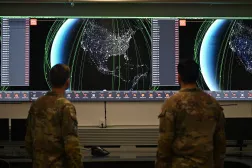Space Development Agency picks 3 vendors to build next layer of missile tracking satellites

The Space Development Agency announced Tuesday that it has tapped L3Harris, Lockheed Martin and Sierra Space to build and operate 54 satellites able to track advanced missile threats, including six space vehicles able to produce data accurate enough to generate an intercept solution.
The satellites will make up Tranche 2 of the agency’s tracking layer, a planned constellation of spacecraft that will give warfighters global coverage of the Earth for missile warning, tracking and defeat missions.
Under the other-transaction prototype agreements — worth a combined $2.5 billion — each company will deliver 18 satellites scheduled to launch by April 2027, according to an SDA press release.
L3Harris’s contract is worth up to $919 million, Lockheed Martin’s is worth up to $890 million and Sierra Space’s is worth up to $740 million, per the release. The three companies beat out six other vendors that competed for the contract awards, an SDA official told reporters Tuesday.
The 54 satellites will be part of SDA’s Proliferated Warfighter Space Architecture (PWSA), which is expected to include hundreds of space vehicles in low-Earth orbit that carry critical technologies for data transport and missile defense missions. The tracking layer — which will consist of approximately 100 satellites, the SDA official said — aims to provide continuous coverage of the Earth and will integrate with the meshed communication network provided by PWSA’s transport layer.
Each of the three companies tapped for the Tranche 2 tracking layer will build 18 satellites: 16 missile-warning/missile-tracking satellites equipped with infrared sensors, as well as two satellites carrying infrared sensors that offer a “preliminary” fire control-quality capability for missile defeat, the official said.
While missile warning and tracking data helps warfighters identify potential threats, fire control-quality data includes more detailed information on a missile’s position, speed and time accuracy — allowing operators to accurately guide an interceptor to a location and defeat the threat.
“We are delivering missile warning/missile tracking globally, and we’re providing preliminary fire control capability in Tranche 2 tracking,” the official said.
The six fire control satellites in Tranche 2 include multiple designs that were built upon the Missile Defense Agency’s Hypersonic and Ballistic Tracking Space Sensor (HBTSS) program, they noted. SDA’s Tranche 2 tracking payloads will include a mix of medium-field-of-view and wide-field-of-view sensors, which will help both agencies and the larger missile defense community understand the needs for future capabilities, the official added.
The agency is also soliciting industry for a separate experimental constellation of satellites that will provide fire control-quality data under the Fire-control On Orbit-support-to-the-war Fighter (FOO Fighter) program.
The recent award is yet another win for both L3Harris and Lockheed Martin, as both companies are heavily involved in other aspects of the Space Development Agency’s PWSA program. L3Harris is already contracted to deliver satellites for both Tranche 0 and Tranche 1 tracking layers, while Lockheed Martin is developing satellites for both the tracking and transport layers.
Meanwhile, this is Colorado-based Sierra Space’s first award from SDA.
“The marketplace is responding to the demand signals for our spiral development model,” SDA Director Derek Tournear said in a statement. “The agile response across the space industry is critically important as we deliver to the warfighter this no-fail mission capability of missile warning, missile tracking, and missile defense.”






